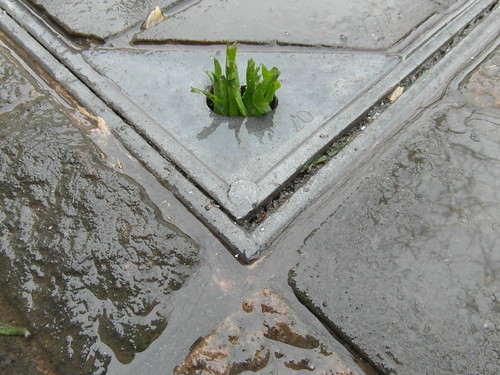Most of the Easter Holidays was spent on DIY and the endless work it seems to spawn. But we spared a day to go to London. We were at the Barbican for These New Puritans and the vast JohnPaul Gaultier retrospective but you are wasting a visit to the Barbican if you don't go for a wander in the concrete gardens.
This is Tim Science under a white sky; note the large planters, some integrated into the design of the entire space, others write-ins, fashionable raised beds full of vegetables and edibles bright green with early season enthusiasm. Concrete brut and cluttering greenery; the perfect companions for the utopian future.
Wednesday 30 April 2014
Friday 25 April 2014
Seeding the waterlily planters
I ordered water lilies off the internet for the planters, picking the tiniest dwarf flowers I could. I ordered from Water Lilies direct as they had the best choice of pygmae (mini ones) I could find. Tim Science (who plays a mainly advisory role in the garden) fancied a red one, but as usual the broad choice diverted us, a I ordered an apricot coloured Nymphaea Aurora, and Nymphaea Laydekeri Lilacea, a pink and white super-miniature. Here they are settling in - and what's that growing with it?

Duckweed. It came in with the seed water from the ponds (a bucket of water taken from an existing pond, which is a crucial part in making sure you get water snails and other beneficial beasties). Rough with the smooth, and like all my other perennial weeds, it'll compost just fine.

Duckweed. It came in with the seed water from the ponds (a bucket of water taken from an existing pond, which is a crucial part in making sure you get water snails and other beneficial beasties). Rough with the smooth, and like all my other perennial weeds, it'll compost just fine.
Thursday 24 April 2014
Bringing the outdoors indoors
I've been sorting out my studio (only 3 years after moving in - or is it 5?) prompted by the discovering that decorating decisions made by previous owners had inadvertently transformed the room (small, upstairs) into a perfect garden for black mould. In case you're curious, here is the process, instructables-style.

- Roughly remove the original paintwork, and lightly damage the plaster surface. The resulting uneven surface will create pockets where moisture can gather under your wall coverings, very important for making sure the mould penetrates the plaster deeply.
- Cover your ventilation brick thoroughly, I mean, bury the bugger. Leave that open to the air and you will just get ventilation. And what does ventilation mean? Drafts. And what does black mould hate? Moving air. Bonus if you can stuff it full of something that mould likes. Old newspaper for example. Double bonus if you can cover it with something else mould friendly. I'm thinking corrugated cardboard.
- Cover your uneven surface with shiny lining paper. This will make a "key" for your main wall covering and create an additional condensation surface when the wall-coverings delaminate. Don't worry about using actual wallpaper paste for this - just use anything.
- Impermeable membrane time! Make it a thin one (perhaps that lovely product which is made of a double layer of silvery stuff and thin black plasticoted paper). This will ensure more moisture in the upper delaminated areas, and that's the really important thing, because you're now in the main growing area.
- Now you need something textured and deep to make a really good surface for growing mould. The people in my house used thin polystyrene tiles, which has the added bonus of being both a good condensation gatherer in itself and a severe fire risk.
- It is now wallpaper o'clock. Think deep, thick, soft paper which will sop up water like blotting paper. You're probably thinking woodchip, but there are actually lots of different textured papers on the market, so pick something nice! Or something horrible, as it'll just get eaten by mould. If you have problems getting this to stick to the polytiles, try another layer of lining paper, but go for something a bit softer and more absorbent this time, for better water retention.
- Paint over it all. Use a problem paint with plenty of plastic in it so the paper can't breathe. Bonus if you use something so vile and densely coloured that the next person in the house has to put three layers of extra light-reflecting white over the top, as that'll keep the moisture where it needs to be, in those steadily delaminating wallpaper layers.
- Brilliant! Your mould garden will be ready in between seven months and seven years, depending on environmental factors (presence/absence of wall cavity, usage of room, etc.).

Saturday 19 April 2014
Wednesday 16 April 2014
Tiny Gardens are Everywhere

At this time of year there are tiny gardens scrambling out of every crack and crevice. They may be mostly weeds. They are probably destined to be washed out in a wet splash or burned dry in a hot weekend, and those who make it through are probably destined for the hoes and sprays of the sweepers of streets.
But in their brief hectic moment they remind us not to: weed paths, keep driveways clear, take moss off walls, strip the Nigella and strawberries from the mortar cracks which they always colonize; pull out the hazel seedlings that spring up everywhere thanks to our friendly neighbourhood squirrels.
Later, when they're concrete-shattering bullies sprouting buddliea and willowherb tendencies, then we can deal. For now, let them riot.
Friday 11 April 2014
MANIFESTO #1
The punk gardener respects no rules of gardening. There are no right or wrong combinations, planting schemes, soils, aspects. Each garden is unique and therefore previous knowledge is of no use. You must start again, anew, alone.
The punk gardener is in love with rot, filth, dirt, slime and soil. Their hands are always dirty, their knees crusted with muck, twigs in their hair and grass stains on their clothes. Gardening is not nice, elegant, tidy. It is a dirty business and making dirt is the first and most important step.
The punk gardener understands that their garden exists in a state of permanent war, in which they are the greatest traitor. Bugs fight against plants, weather fights against plants, and above all plants fight, fight, fight against against plants. By turns betrayer, turncoat, fair weather friend, terrorist, brute and beast, the gardener is never on any side, nor following any rules of engagement. They follow their inner directives, and their faith cannot be relied on.
The punk gardener understands that their garden is food for everything and that everything is food for their garden.
The punk gardener is not making a statement. They are growing plants.
Subscribe to:
Posts (Atom)
